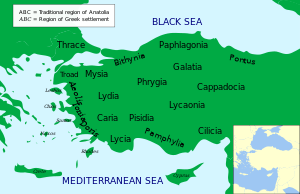بيثينيا
| منطقة قديمة في الأناضول Bithynia (Βιθυνία) | |
| الموقع | شمال الأناضول |
| فترة الدولة: | 297-74 ق.م. |
| الأمة | بيثيني, ثيني, الإغريق |
| العواصم التاريخية | نيقوميديا, نيقايا |
| مقاطعة رومانية | بيثينيا |
بايثينيا (Bithynia ؛ /bɪˈθɪniə/؛ يونانية كوينه: Βιθυνία؛ Bithynía) كانت بلدة قديمة في آسيا الصغرى، تمتد على طول الساحل الجنوبي للبحر الأسود. جاء شعب بِثينيا أصلاً من تراقيا فيما يعرف الآن بأوروبا الشرقية. أنشأ الإغريق مستعمرات في خلقيدونيا (وهي مدينة قديمة بآسيا الصغرى على البوسفور)، وهرقلية. فتح الفُرس بثينيا في القرن السابع قبل الميلاد. كانت بثينيا مملكة مستقلة من عهد الإسكندر الأكبر (356 – 323 ق.م.)، وإلى أن ضمتها روما إليها في سنة 74 ق.م. حُكمت بثينيا من قبل پليني الأصغر، في وقت مبكر في القرن الثاني الميلادي. وتظهرُ مدى قوة النصرانية في رسالة بليني إلى الإمبراطور تراجان، حول كيفية معاملة النصارى في بثينيا.
التاريخ

العصر الحديدي
Bithynia is named for the Thracian tribe of the Bithyni, mentioned by Herodotus (VII.75) alongside the Thyni. The "Thraco-Phrygian" migration from the Balkans to Asia Minor would have taken place at some point following the Bronze Age collapse or during the early Iron Age. The Thyni and Bithyni appear to have settled simultaneously in the adjoining parts of Asia, where they expelled or subdued the Mysians, Caucones and other minor tribes, the Mariandyni maintaining themselves in the northeast. Herodotus mentions the Thyni and Bithyni as settling side by side.[1] No trace of their original language has been preserved, but Herodotus describes them as related to the tribes of Thracian extraction like the Phrygians and Armenians, whose languages may form part of the Paleo-Balkan group (although this is not certain and the theory is not universally accepted).
Later the Greeks established on the coast the colonies of Cius (modern Gemlik); Chalcedon (modern Kadıköy), at the entrance of the Bosporus, nearly opposite Byzantium (modern Istanbul) and Heraclea Pontica (modern Karadeniz Ereğli), on the Euxine, about 120 miles (190 km) east of the Bosporus.[2]
The Bithynians were incorporated by king Croesus within the Lydian monarchy, with which they fell under the dominion of Persia (546 BC), and were included in the satrapy of Phrygia, which comprised all the countries up to the Hellespont and Bosporus.[1]
مملكة بيثينيا
Even before the conquest by Alexander the Bithynians appear to have asserted their independence, and successfully maintained it under two native princes, Bas and Zipoites, the latter of whom assumed the title of king (basileus) in 297 BC.
His son and successor, Nicomedes I, founded Nicomedia, which soon rose to great prosperity, and during his long reign (ح. 278 BC), as well as those of his successors, Prusias I, Prusias II and Nicomedes II (149 – 91 BC), the kingdom of Bithynia had a considerable standing and influence among the minor monarchies of Anatolia. But the last king, Nicomedes IV, was unable to maintain himself in power against Mithridates VI of Pontus. After being restored to his throne by the Roman Senate, he bequeathed his kingdom through his will to the Roman republic (74 BC).[2]
The coinage of these kings show their regal portraits, which tend to be engraved in an extremely accomplished Hellenistic style.[3]
المقاطعة الرومانية
كمقاطعة رومانية، تغيرت حدود بيثينيا عدة مرات. وأثناء تلك الفترة، شاع اتحاد بيثينيا، لأغراض ادارية، مع مقاطعة پنطس. وقد كان هذا هو الوضع في عهد الامبراطور تراجان، حين عـُيـِّن پلني الأصغر حاكماً على المقاطعتين المضمومتين (109/110 – 111/112)، وهو الظرف الذي أمدَّ المؤرخين بمعلومات قيمة عن ادارة المقاطعات الرومانية آنذاك.
أصبحت مدينة نيقوميديا البثينية، العاصمة الشرقية للإمبراطورية الرومانية، تحت حكم الإمبراطور ديوكليشيان في أواسط الثمانينيات من القرن الثالث الميلادي.
المقاطعة البيزنطية
Under the Byzantine Empire, Bithynia was again divided into two provinces, separated by the Sangarius. Only the area to the west of the river retained the name of Bithynia.[2]
Bithynia attracted much attention because of its roads and its strategic position between the frontiers of the Danube in the north and the Euphrates in the south-east. To secure communications with the eastern provinces, the monumental bridge across the river Sangarius was constructed around 562 AD. Troops frequently wintered at Nicomedia.
During this time, the most important cities in Bithynia were Nicomedia, founded by Nicomedes, and Nicaea. The two had a long rivalry with each other over which city held the rank of capital.
أشخاص بارزون
- هيپارخوس (القرن الثاني ق.م.) فلكي يوناني، اكتشف مبادرة الأجرام واكتشف كيف يتوقع توقيت الكسوف
- ثيودوسيوس (القرن الثاني ق.م.) فلكي وعالم رياضيات يوناني
- أنتينوس (القرن الثاني) غلام الامبراطور الروماني هادريان
- كاسيوس ديو (القرنين 2-3) مؤرخ روماني، سناتور و قنصل
- آريانوس (لوكيوس فلاڤيوس آريانوس) مؤرخ، ح. 86-160
- هلينا (امبراطورة)، قديسة وأم قسطنطين الأكبر ح. 250
- فرينيخوس العربي، (القرن الثاني) نحاء
انظر أيضاً
الهامش
- ^ أ ب Chisholm 1911, p. 12.
- ^ أ ب ت Chisholm 1911, p. 13.
- ^ Asia Minor Coins - regal Bithynian coins
المصادر
للاستزادة
- Storey, Stanley Jonathon (1999) [1998]. Bithynia: history and administration to the time of Pliny the Younger (PDF). Ottawa: National Library of Canada. ISBN 0-612-34324-3. Retrieved 2007-05-21.
- T. Bekker-Nielsen, Urban Life and Local Politics in Roman Bithynia: The Small World of Dion Chrysostomos, 2008.
- Articles containing Ancient Greek (to 1453)-language text
- Articles with hatnote templates targeting a nonexistent page
- Turkey articles missing geocoordinate data
- All articles needing coordinates
- مناطق تاريخية في الأناضول
- مواقع يونانية قديمة في تركيا
- تاريخ تركيا
- مقاطعات روما القديمة
- بيثينيا
- مقاطعات الإمبراطورية البيزنطية
- دول وأراضي تأسست في 297 ق.م.
- انحلالات 274 ق.م.



